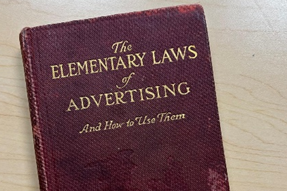A friend of mine gave me a vintage advertising book entitled “The Elementary Laws of Advertising and How To Use Them,” published in 1913. Back then, it sold for two bucks, which is the equivalent of more than $62 today, so it was no small investment. The author, Henry Bunting, begins the book by saying he wanted to identify “the bedrock facts at the bottom of the advertising game.” Having searched for such things for my entire professional career, I had to read it.
A look into the past

In historical terms, 1913 wasn’t that long ago. In advertising terms, it may as well be an eternity. One hundred and ten years ago, there not only were no websites or streaming services, there were no television networks or radio stations. Because advertising was still in its infancy, there was less consumer cynicism resulting from being burned by overstuffed promises and not yet a Federal Trade Commission keeping an eye on questionable claims.
The 1910s were the halcyon days of companies like General Motors, Ford, DuPont and General Electric, and in that decade, the average American family saw its income more than double. Perhaps unsurprisingly, this was the moment when the “scientific” approach to advertising began to make its bold claims, and authors like Bunting were the first to espouse them.
For context, as I read the book, I looked back on some of the advertising from that era, and let’s just say some things have changed since then. In 1913, an ad for Encyclopedia Britannica touted it as “The Sum of Human Knowledge,” citing as evidence its 29 volumes, 28,150 pages and 44 million words. A century later, Encyclopedia Britannica’s “sum of human knowledge” would be exponentially exceeded by online search engines to the point where it would no longer even be printed. (It can now be found exclusively online.)
Also, in 1913, an ad for the Underwood typewriter said it had “No Rivals in Speed and Accuracy,” as it held all the world records in open competition. In a bit of hubris, the ad claimed that Underwood was “The Machine You Will Eventually Buy” (which proved true of my forebears, as I learned to type on a hand-me-down Underwood). That said, as with encyclopedias, typewriter technology would eventually be surpassed, and Underwood, ahem, met the undertaker.
Seeing into the future
Despite what’s different these days, I have to say that Bunting surprised me with how much he got right. For instance, he identified 15 elements of advertising that still largely hold true today, from the importance of it being attention-getting to the significance of reach and frequency to the power of persuasiveness. He also made the point that there is no “public” but only a “collectivity of individuals” and that individual preferences are not always based on “sound judgment.” We now know that to be indisputably true.
Bunting also explored in some depth the concept of “suasion” (a synonym for persuasion), such as when a cereal company claims that “professors, preachers, and brainy men, in general, eat oats for breakfast,” an automobile manufacturer associates the word “noiseless” with a picture of the machine and a fountain beverage is “tipped as ‘refreshing.’”
That led to the most impressive insight in the book: Bunting’s prescient understanding of the importance of brand ideas. He says:
Discover and use an identification idea, not necessarily a trademark, but an idea. Make this idea your own, and the moment you see others trying to imitate you, shift the form, and then their use of your original idea will react on them by serving to sell your goods, not theirs. The law of association will carry the individual into your own camp. (Emphases in the original.)
That’s a quote a modern branding professional could use almost verbatim, citing examples from Coca-Cola to Nike to Walmart.
Humor and principles that last
Bunting’s insight wasn’t perfect. He states somewhat emphatically that special care should be taken to avoid humor in advertising. “Men like to laugh,” he says, “but they are, after all, only one-tenth fool, and buying and selling are always serious matters.” As I noted a century later in my own book, “Power Branding,” we have since learned that a humorous brand is a confident brand, and a confident brand is attractive.
Speaking of humor, I chuckled at Bunting’s dig at advertising agencies: “In these days, everybody who has failed in everything else in which he has embarked goes into ‘the advertising business.’” Harsh words but — as anyone who has had the wool pulled over their eyes by someone with a laptop and business card knows — not entirely untrue.
Despite some archaic references and language, the book has held up well. And I suppose that’s the larger point. Perspectives and possibilities change, processes and procedures change, but principles never change. A student of advertising today would do well to master the basics before proffering an opinion on any of the above P’s, or advising a company regarding its product, price, place or promotion (long known as the Four P’s of Marketing).
We know that companies and the people who run them come and go and that markets, media and messaging are in constant flux. In such a world, it’s good to remember some things remain reliably true.
Steve McKee is the co-founder of McKee Wallwork, a marketing advisory firm that specializes in turning around stalled, stuck and stale companies. McKee is the author of “TURNS: Where Business Is Won and Lost,” “When Growth Stalls” and “Power Branding.”
Opinions expressed by SmartBrief contributors are their own.
____________________________________
Take advantage of SmartBrief’s FREE email newsletters on leadership and business transformation, among the company’s more than 250 industry-focused newsletters.
